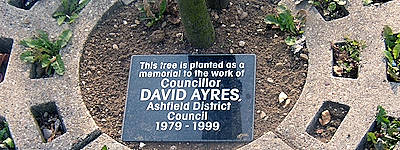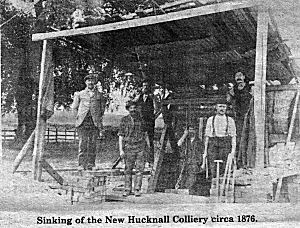Reference Library
Local Understandings
Cllr David Ayres

A plaque under planted trees edging Huthwaite Market Place pays tribute to an Ashfield District Councillor of 20 years. Death of their former leader was respectfully given two minutes silence at next meeting on 29th April, 1999.
David Ayres held address at The Sycamores, 7 Boots Yard, off Main Street, when offering his home village this historical look back in time. Mick Bostock shared Chad clipping, loosely suggesting year of publication around 1990.
On Huthwaite
Notts County Council's Common Road Industrial Estates at Fulwood, Huthwaite, were born in the wake of the rapid run down of Ashfield's pits in the 1960's.
Fortunately, at the same time, the M1 was being pushed northwards providing excellent motorway connections at Junction 28, less than two miles away along the A38 dual-carriageway.
With state assistance, it made an attractive location for new business - and now it boasts an industrial diversification vital to local economy.
What a contrast to the site's origins which stretch back over the centuries.
Huthwaite stands on the very western edge of the county and indeed the boundary of the Council Estate actually forms the border with Derbyshire.
Centuries ago, these pleasantly undulating fields, with their magnificent views over towards the Peak, on which the new factories were built, were a dense forest.
Fulwood was part of Sherwood Forest, the great "Shirewood" of Nottinghamshire. Fulwood meant literally "a foul dirty wood" and is spelled Fulewood in records as early as 1287.
In a survey of the forest taken during the reign of Henry VIII in 1539, Fulwood is called "the coppice of the Lord the King" - a coppice being a wood managed for timber.
But even more interesting, the survey then goes on to describe what are virtually the boundaries of the present day industrial estates.
"And so by the boundaries of Fulwood round about up to (South) Normanton Lane ... and from thence about the fields of Dirty Hucknall and Houthwell ..."
Dirty Hucknall and Houthwell both refer to Huthwaite, mistakenly thought by many people to be a late 19th century industrial village.
But there are references to Hothweit as early as 1208, and the village almost certainly originated around 900 AD, with the Danish "Huth" meaning hill and "Thwaite," a forest clearing, an accurate description surely in those times.
Calling Huthwaite "Dirty Hucknall" in the 1537 survey throws up a fascinating mystery for locals. The name first appears in legal records in 1519 as "Dirti Huckenall" when Huthwaite was also known as Hukenall under Hucthwet, and the prefix Hucknall survived to confuse travellers until 1907.
Huthwaite folk have long had to suffer jocular remarks about them coming from "Dottie 'Uckna," but most assumed it stemmed from the days when the village's awful roads were liberally strewn with coal dust shaken from the carts bumping up the steep hills from the pits.
Yet the name appeared over 450 years ago, long before any large scale mining could have occurred, so its origin must lie in some other long forgotten reason.
Huthwaite has had links with industry for at least the last 200 years. The old Hucknall pit was sunk at the bottom of Blackwell Road, near its junction with Nunn Brook Road, in 1761, and the village was well known by the end of that century for quality cotton and woollen hose produced by its frame-work knitters in their own homes.
Then just over a century ago the real expansion of the village began with the sinking of the New Hucknall Colliery on the east side of Common Road in 1876 by local businessmen headed by William Muschamp and the Bainbridge family.

Closed in 1982, New Hucknall was a boom colliery in its early years, employing nearly 1,200 men in the 1890s and providing the profits for the owners to start another successful enterprise, Bentinck Colliery.
Stone And in another unique way, Huthwaite's family pit will never be forgotten, for All Saints' Church at the top of Common Road with its commanding view over the estates, was built early in this century with stone hewn from the deep hard seam, 400 yards below ground.
Bordering the other side of the Fulwood Estate at New Bridge are the forlorn reminders of another bold visionary enterprise, Sir Edward Watkin's Great Central Railway.
The legendary Victorian railway promotor spent a staggering £12m at the turn of the century building what proved to be the last main line in Britain, linking his Manchester, Sheffield and Lincs railway from Nottingham Victoria terminus to London Marylebone.
Watkin also vigorously urged the building of the Channel Tunnel and planned to run trains along his superbly-engineered line direct from Manchester to Paris.
Sadly, the ambitious Great Central was the major casualty of the Beeching Axe in 1963 and Huthwaite never did get its promised station at Fulwood.
But today the vital rail links for businessmen are provided by the new Alfreton and Mansfield Parkway station.
09 Aug 14 by David Ayres Updated 09 Aug 14
